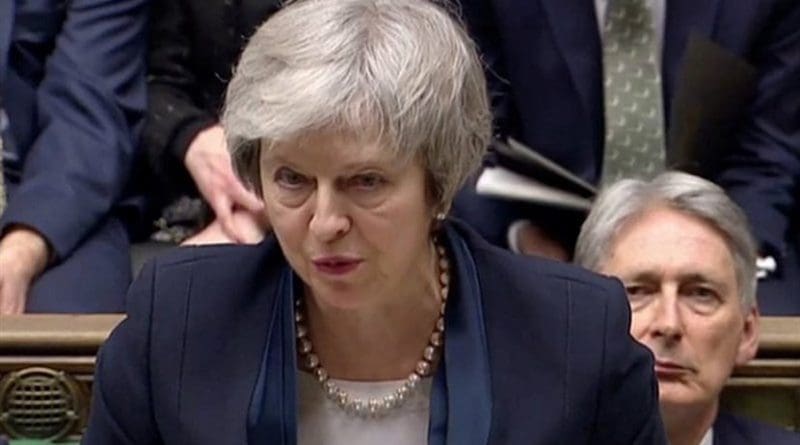May’s Chances Of Delivering Brexit On Time Remain Slim – OpEd
By Arab News
By Andrew Hammond*
UK Prime Minister Theresa May is making final preparations for a second vote — on Monday or Tuesday next week — on her Brexit withdrawal deal. While this agreement was defeated in January by a historic margin, she is now pulling out all the stops to try to complete what would be a remarkable turnaround.
While the odds are still against her, she is making ground and a surprise victory cannot be ruled out.
With much political horse trading still to come before the vote, the mathematical pathway for May to win is relatively clear, albeit tough to realize in practice. May was defeated in January by 432 votes to 202, which was the largest defeat for a sitting UK government in the modern democratic era. In the absence of abstentions, May would need at least 116 MPs to be converted to her side of the argument. Here she is deploying a range of tactics on three fronts.
Firstly, and most pressingly, May needs to win the majority of the missing votes from her own backbenchers. Remarkably, 118 Tories voted against her deal in January, which is more than a third of the parliamentary party. One signal that the Conservative rebellion over May’s withdrawal deal will narrow next week came on Feb. 27, when “only” 20 Conservative MPs voted against an amendment that contained May’s commitment to giving Parliament a vote on delaying Brexit if both her deal and no deal are rejected.
The prime minister is unlikely to win the votes of a number of the hardest-line euroskeptics among her backbenchers, as their concerns go well beyond the Irish backstop. However, at least half of the 118 rebel MPs are usually reliable loyalists who vote with the government and are actively looking for political cover to support May next week.
These loyalists include Sir Graham Brady, the chairman of the backbench Tory 1922 Committee, who indicated at the weekend that he will support the government if it can secure sufficient concessions from Brussels on the Irish backstop. Brady’s comments will influence other MPs, hence why so much could rest on the fate of the negotiations being led by Attorney General Geoffrey Cox MP. He is aiming to secure further legal assurances, potentially in a codicil, that the Irish backstop will not become a permanent arrangement that would leave the UK effectively tied up in a customs union with the EU, which is strongly opposed by Brexiteers.
A further reason why the Tory rebellion over May’s withdrawal deal is likely to be smaller next week than in January is May’s concession of a vote for potentially delaying Brexit Day (March 29). This ballot will only happen, however, if her exit agreement is voted down again and there isn’t a majority in favor of a no-deal departure.
It is likely, but no means certain, that the Commons would take up the opportunity to extend Article 50. This potential danger for Brexiteers is concentrating their minds as, if May’s deal fails again, euroskeptics could end up with a delayed UK exit of the EU at best, or potentially the prospect of a further referendum, given the shift in the opposition Labour Party’s stance toward backing such a public vote.
Outside of Conservative ranks, the second related element of May’s political tactics for next week is focused on the 10 Democratic Unionist Party (DUP) MPs who have propped up her government since she lost her majority in the Commons in 2017. While the 10 DUP votes are not huge in number, if the PM can get them all on board it could also help influence the votes of some Tory Brexiteers. As with many Conservative rebels, the DUP are closely scrutinizing Cox’s negotiations with the EU, which on Tuesday appeared to be stalling, as they have also insisted on “legally binding changes” around the Irish backstop.
The third pillar of May’s strategy is seeking to peel off Labour MPs (and former Labour MPs such as Ian Austin, who left the party last week) who represent constituencies that voted leave in the 2016 referendum. In January, May’s deal got the support of just three Labour representatives. Yet, in another Brexit vote later that same month, 14 Labour MPs backed the government and eight more abstained. May is hoping that significantly more Labour MPs will support the deal in next week’s vote, including those who disagree with the party’s support for a second referendum and want to see the nation leave the EU sooner rather than later.
To try to secure as much Labour support as possible, the prime minister outlined this week some £1.6 billion ($2.1 billion) in new funding for deprived English towns, plus a package of greater guarantees for workers’ rights post-Brexit.
One other possibility, which could see May’s deal ultimately passed easily, would come if the House of Commons supports an amendment proposed by Labour backbenchers Peter Kyle and Phil Wilson. If approved by the Labour leadership, this amendment would see Labour abstain on May’s deal in return for a second referendum, in which the agreement — and other options to be defined — would be put to a public vote.
Taken overall, the mathematical pathway to May securing enough votes next week is clear and there is a growing outside chance that she will be able to get her deal through the Commons. However, her back remains against the wall, and she and her government still have a massive job ahead if they are to pull off a surprise win.
• Andrew Hammond is an Associate at LSE IDEAS at the London School of Economics

